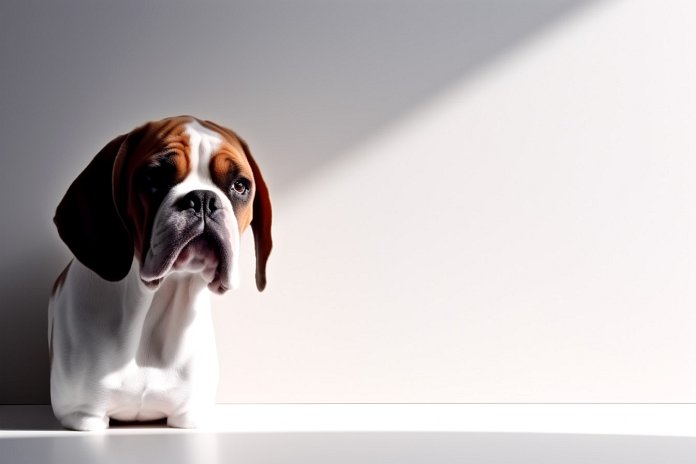
A Bully Basset is a hybrid breed that comes from a mix of a Basset Hound and a Bulldog. This dog is known for being friendly and affectionate, making them a great companion. They are not very active, so they can live happily in any type of home, whether it’s an apartment or a house with a yard. Unlike some other breeds, they don’t need tall fences because they are not climbers. However, they do need regular exercise to prevent them from becoming overweight.
The Bully Basset is famous for snuggling with their family members, but they also enjoy playing. Depending on the size of their parents, they can range in size from medium to giant. While they make excellent family pets, they can sometimes be independent and stubborn, so it’s important to have an experienced owner who can handle them.
Below, we look at Bully Basset dog breed, its history, personality, pros and cons of owning an Bully Basset, characteristics, and must-know facts. We will also examine how to care for this breed and much more. Prepare for a tail-wagging adventure into the world of Bully Bassets!
| Dog Breed | Bully Basset |
| Size | Medium |
| Weight | 40-60 lbs (average) |
| Height | 12-16″ (average) |
| Location | United States |
| Ancestry | Basset Hound and Bulldog |
| Date of Origin | Unknown |
| Group | Companion, Watchdog |
| Life Expectancy | 10-12 years |
| Price | $300 – $500 |
| Family | Canidae |
| Scientific Name | Canis Lupus Familiaris |
📖 Breed History
The origins of the Bully Basset are not fully known, but we do have information on the parent breeds, the Basset Hound and Bulldog. The Basset Hound is believed to be a descendant of the St. Hubert Hound, which is also an ancestor of the Bloodhound. The Basset Hound is thought to have come about as a mutation in the St. Hubert breed, resulting in a smaller version of the Bloodhound. These dwarf hounds were eventually intentionally bred due to their excellent skills in tracking rabbits in thick forests. The Basset Hound gained popularity in France and was introduced to England in 1874 by a French nobleman. The breed was later shown in an English dog show in 1875 and gained attention from the Princess of Wales. It is not certain how the Basset Hound came to the United States, but it became popular around 1928 after a story featuring a Basset Hound puppy was published in Time magazine. In the 1960s, the Basset Hound became associated with the Hush Puppy shoe brand and the Fred Basset comic strip. The breed is celebrated in the United States with picnics and “waddles,” which are events that bring Basset Hound owners together and raise money for Basset Hound rescues.
The Bulldog is thought to be a descendant of the Mastiff and was originally bred for bull-baiting. This breed was also used in fighting, but now it is known for being a beloved companion. The Bulldog has a large head and muscular body, and it is the 4th most popular dog breed according to the American Kennel Club. The Bulldog has evolved from its original purpose and is now cherished as a family member and friend. It serves as a mascot for the United States Marine Corps, universities, and sports teams. The breed is dignified and respected, no longer the ferocious fighter it once was. The Bully Basset is recognized by several dog organizations, including the American Canine Hybrid Club, Designer Dogs Kennel Club, Dog Registry of America, and International Designer Dog Canine Registry.

🐕 Bully Basset Appearance
The size of the Bully Basset is medium to big. The Bully Basset’s color will vary depending on the parent breeds, but he is often tan or fawn in color with a white chest and stomach. Occasionally, the Bully Basset will also be tricolored, meaning that he will be either black and white or red and white. On rare occasions, a lemon and white hue will appear. He frequently has white legs as well. The Bully Basset often inherits the Basset Hound’s floppy ears, and he may or may not have the parent’s facial wrinkles.
| 👀 Eye Color | Brown |
| 🐽 Nose Color | Black |
| 🐕 Coat Color | Pied, White, Fawn |
⚡ Fun Fact: Bully Basset dogs are a social breed. They enjoy being around people or other animals. This breed doesn’t tolerate being left alone.
🐶 Traits & Temperament of Bully Basset
The Bully Basset is a sociable, amiable, extroverted, and pleasant dog, yet he can also be headstrong. since of this behavioral feature, the Bully Basset is not advised as a good dog for inexperienced owners since training can be challenging. Owners ought to be persistent, upbeat, and patient. Make sure you have enough of chew toys on hand because the Bully Basset is also known to be a chewer. You might need to often divert chewing propensities toward the toys. Additionally, training Bully Bassets takes more time than training many other breeds. The Bully Basset is an all-around gentle, loving dog who adores his family and is especially wonderful with children. It is advised to start socializing and training your dog at a young age for the greatest possible relationship.
🤝 Are Bully Bassets Friendly or Aggressive?
The Bully Basset is known for being an extremely friendly breed of dog. They get along well with strangers, children, cats, and other dogs. They particularly enjoy being around children and are very kid-friendly. If you’re looking to add more dogs to your family or participate in dog meetups, the Bully Basset would be a great choice. Additionally, they are considered one of the best breeds for elderly people, as they are gentle and easy to handle.
This breed is known for being:
- Loving
- Courageous
- Friendly
- Affectionate
- Devoted
- Gentle
- Social
- Tempered
- Sweet
- Aggressive
- Tenacious
🐩 Bully Basset Care & Maintenance
The Bully Basset does have a propensity to shed, so he can need a lot of upkeep. Daily brushing with a wire-bristle brush is recommended for him. Only bathe him when it’s essential. At least three times a week should be plenty to brush your Bully Basset’s teeth; daily brushing is recommended if you want to avoid gum disease. Trim the Bully Basset’s nails at least every two weeks, and more frequently if they develop cracks, rips, or breaks. It’s important to keep the skin’s folds, which can be seen in the Bully Basset, dry. If dirt and moisture are allowed to remain on the skin, germs can quickly accumulate and cause odor and irritability.
Bully Basset dogs have a moderate level of shedding, which is a normal part of their hair growth cycle. Regular brushing can help minimize the amount of hair that is shed. The extent of shedding can vary depending on the dog’s overall health and the specific breed they belong to. In terms of bath time, it is recommended to give these dogs a bath every 4-6 weeks to keep their coat clean and healthy.
🍖 Food: We recommend 3 cups daily, costing you about $1.50 – $1.90 daily, or approximately $39.00 – $52.00 a month.
🐾 Exercise: Bully Basset dogs exercise need is minimal. If you live a slow life, this breed can be a good choice for you.
This dog breed requires to be walked for roughly 7 miles per week, which equates to about 45 minutes of physical activity daily. This consistent moderate exercise regimen will help maintain their physical wellness and significantly contribute to their mental stimulation. Consciously setting aside this time for your furry friend can dramatically enhance their life quality, helping them stay energetic, healthy, and mentally alert.
Did you know: Bully Basset dogs have a lower energy level than other dogs. If you live a chilled life, this breed can be a good choice for you.
❤️🩹 Bully Basset Health & Issues
Some of the major concerns for Bully Basset Dog Breed can be:
- Patellar Luxation
- Gastric Torsion
- Allergies
- Hip Dysplasia
- Reverse Sneezing
- vonWillebrand’s Disease
While minor concerns include:
- Ear Infections
🤧 Important: Is Bully Basset hypoallergenic? No.
✨ Bonus: Check out cool, creative, and funny names for Bully Basset.
⚡ Bully Basset Dog Breed Facts
What makes the Bully Basset a great choice for families with young children?
The Bully Basset is a great choice for families with young children because they are known to be friendly, happy, and affectionate. They love their family members, including children, and are especially good with kids.
Is the Bully Basset breed considered a suitable breed for apartment living?
Yes, the Bully Basset breed is considered suitable for apartment living. They are adaptable and can be happy in any type of home, whether it be an apartment or a home with a yard. High fences are optional as they are not climbers.
How much exercise does a Bully Basset require compared to other breeds?
The Bully Basset requires daily exercise to fight a tendency towards obesity. While they are fairly active, their exercise needs are not specified compared to other breeds.
Is the Bully Basset breed known for being good with other pets?
The Bully Basset breed is known to be good with other pets. However, it is always important to introduce them properly and ensure proper socialization.
What are other low-maintenance dog breeds similar to the Bully Basset?
Some low-maintenance dog breeds similar to the Bully Basset include the Bulldog and the Basset Hound, which are its parent breeds.
What are the common health issues that Bully Bassets are prone to?
Bully Bassets are prone to certain health issues, although specific ones are not mentioned in the given text. It is always recommended to consult a veterinarian for a comprehensive understanding of a breed’s health concerns.
Are Bully Bassets known to be easy to train compared to other breeds?
Training the Bully Basset can be somewhat difficult due to their stubborn personality trait. Therefore, they are not recommended as a good breed for novice owners. Patience, positive reinforcement, and consistency are crucial during training.
Are Bully Bassets more prone to separation anxiety compared to other breeds?
The Bully Basset breed may be more prone to separation anxiety compared to other breeds, as it is not mentioned in the given text.
Are there any dog breeds similar to the Bully Basset that are suitable for people with allergies?
There may be other dog breeds similar to the Bully Basset that are suitable for people with allergies, such as hypoallergenic breeds like the Poodle or the Bichon Frise. However, this information is not provided in the given text.
What sizes of dogs similar to the Bully Basset are best for individuals or families with limited space?
Since the Bully Basset is described as a medium-to-large sized dog, individuals or families with limited space may prefer smaller-sized dog breeds, such as the French Bulldog or the Beagle.
Is the Bully Basset breed known to be good with children with special needs?
Based on the given text, the Bully Basset breed is known to be good with children. However, whether they are specifically good with children with special needs is not mentioned.
How does the grooming and shedding needs of the Bully Basset?
The grooming and shedding needs of the Bully Basset are not described in the given text. It is recommended to consult a professional groomer or a veterinarian for specific grooming requirements of the breed.
We use reliable and publicly available data and resources such as AKC and American Canine Registry to ensure that Bully Basset dog breed information is accurate and up to date. If you spot an error, please don’t hesitate to bring it to our attention.